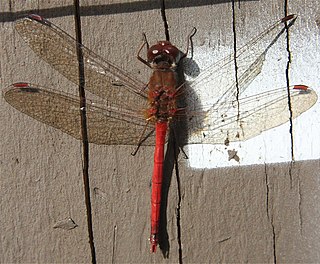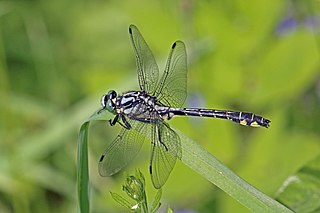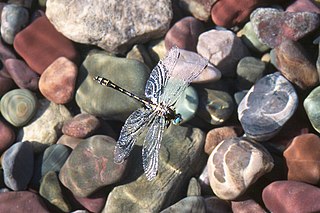
Odonata is an order of flying insects that includes the dragonflies and damselflies. Members of the group first appeared during the Triassic, though members of their total group, Odonatoptera, first appeared in Late Carboniferous.

Damselflies are flying insects of the suborder Zygoptera in the order Odonata. They are similar to dragonflies, which constitute the other odonatan suborder, Anisoptera, but are smaller and have slimmer bodies. Most species fold the wings along the body when at rest, unlike dragonflies which hold the wings flat and away from the body. An ancient group, damselflies have existed since at least the Lower Permian beginning about 299 million years ago, and are found on every continent except Antarctica.

The black-tailed skimmer is a dragonfly belonging to the family Libellulidae.

The Gomphidae are a family of dragonflies commonly referred to as clubtails or club-tailed dragonflies. The family contains about 90 genera and 900 species found across North and South America, Europe, Asia, and Australia. The name refers to the club-like widening of the end of the abdomen. However, this club is usually less pronounced in females and is entirely absent in some species.

Gomphus is a genus of clubtail dragonflies in the family Gomphidae.

Sympetrum vicinum, the yellow-legged meadowhawk or autumn meadowhawk, is a member of the Libellulidae family. It grows to 26–35 mm long.

Gomphus vulgatissimus, the common clubtail, is a medium-sized species of dragonfly in the family Gomphidae. It is found in most of Europe, and is present now in the south of France. Its natural habitats are clean, slow moving streaming rivers and creeks with sandy soil. It can be seen from mid-April in the south to August. Once they hatched out of water, they live shortly. As the common name suggests, this medium-sized species has a distinctive club-shaped abdomen. The males are black with extensive yellow markings on the thorax and abdomen which turn green as the insect ages. The females are black with extensive yellow markings. In the British Isles the adult flight period extends from mid May to early July.

The band-winged meadowhawk is a dragonfly of the genus Sympetrum belonging to the family Libellulidae.

The dot-tailed whiteface is a species of dragonfly in the family Libellulidae. It is also one of the most common and widespread in the genus Leucorrhinia.

The desert whitetail is a species of dragonfly in the family Libellulidae. P. subornata is often put into the genus Libellula.

Sympetrum madidum, the red-veined meadowhawk, is a species of dragonfly in the family Libellulidae.

The boreal bluet is a species of damselfly in the family Coenagrionidae.

Progomphus borealis is a species of dragonfly in the family Gomphidae. This dragonfly species is commonly known as the gray sanddragon.

Phanogomphus graslinellus is a species of dragonfly in the family Gomphidae. This species is commonly known as the pronghorn clubtail.

The Hudsonian whiteface is a species of dragonfly in the family Libellulidae. Its common name comes from where it is found, Hudson Bay.
Burmagomphus pyramidalis, sinuate clubtail, is a species of dragonfly in the family Gomphidae. It is found in India and Sri Lanka. There are 2 subspecies, where they are geographically separated.

The black marsh skimmer, or light-tipped demon, is a species of dragonfly in the family Libellulidae. It is found in India, Sri Lanka and Thailand.

Phanogomphus is a genus of clubtails in the family Gomphidae found in North America. There are about 17 described species in Phanogomphus.

Gomphurus is a genus of clubtails in the family of dragonflies known as Gomphidae. There are about 13 described species in Gomphurus.

Davidioides martini, Syrandiri clubtail, is a species of dragonfly in the family Gomphidae. It is known only from the Western Ghats of India.





















